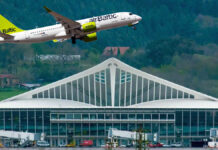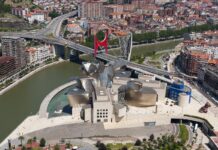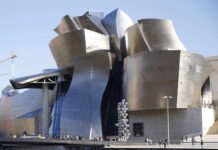On this occasion, we’re going to bring you an article from La Vanguardia about the seven Pritzker prize winning architects who have contributed their works to the transformation of Bilbao.
This is (yet another) exception to our general rule to avoid referencing media from within Spain or France. These exceptions are only made when the subject matter seems interesting or relevant to us, thereby “earning” a place in the blog. Indeed, our readers will soon see yet another one!
Armando Cerra, last April, published an amazing article in the Catalan daily La Vanguardia titled “Bilbao, the Seven-Time Pritzker Prize Winning City.” The article’s subtitle also said quite a lot: “The Biscayan capital has become a laboratory for 21st century architecture and design.” It goes over how these architects are, alongside others who, despite not (yet) having received that award, are in the group of the most renowned.
This award, the Pritzker Prize for Architecture, was set up by the Pritzker family of Chicago via the Hyatt Foundation in 1979. It is awarded annually, and is considered the highest award in the profession. That’s why it’s often called the “Nobel of architecture.”
It honors an architect who has shown off different facets of their talent as an architect through their projects and works, thereby contributing to the enrichment of humanity.
We’ve been holding on to this one, hoping the occasion would arise that would justify including this article on the blog as one of our exceptions. And the entry we just published about architect Dennis Lee in the Hong Kong daily South China Morning Post finally tipped the scales.
This is because it joins in on the arguments that have so often criticized, and continue to do so, the choice of renowned international architects for important projects in Bilbao and throughout our country.
Marshall MacLuhan told us decades ago, when referring to the media that “the medium is the message.” To bluntly paraphrase him, we could say that when it comes to architecture and city planning, the architect, and their work, is the message, a message from a society to the world, and an element of prestige that endures through time.
Hiring a prestigious architect does not incorporate a fundamental cost to the work and, instead, it provides a global reach that has incalculable intangible value.
Nowadays, there are no architects worth their salt on the world stage who wouldn’t be delighted to get in on one of the projects that is transforming the Bilbao metro area, because it is amazing that in a country with only three million inhabitants, there is such a city that has works from seven of the 46 award winning architects inside its limits is nothing to sniff at. It could be said that redesigning Bilbao is a recognition in and of itself.
We only wish we could offer each new winner a project to work on in our country, to maintain that level of prestige and to continue being a laboratory of architecture and design for the 21st century, as the article’s author said.
Somehow, we’ve made up for this limit in another area where we enjoy global prestige: cuisine. We did so by creating the Basque Culinary World Prize, which is awarded to the chefs in the world with a clear social conscience. Despite its “youth,” it has already been called the “Nobel of gastronomy.”
La Vanguardia – 13/4/2023 – Catalonia
Bilbao, la ciudad de los siete premios Pritzker
Arquitectos como César Pelli, Arata Isozaki, Álvaro Siza o Robert Stern han creado edificios icónicos en Kuala Lumpur, Los Ángeles, Lisboa o Disney World. Infraestructuras en los cinco continentes se consideran gigantescas esculturas gracias a Norman Foster o Santiago Calatrava. Y los imaginativos diseños de Philippe Starck o Javier Mariscal enriquecen los edificios más in del planeta. Pues bien, todos estos nombres, junto a otras célebres firmas, conviven en Bilbao.
(Follow) (Automatic translation)
Last Updated on Dec 3, 2023 by About Basque Country
































